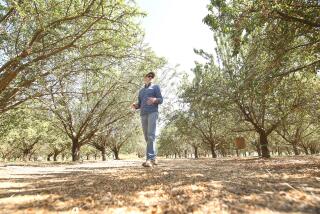Science / Medicine : THE THEORY OF Sexual Selection : Biology: A scientist observing insect mating has classified male flies as ‘studs to duds’ and females as loose or choosy. He believes differing courtship standards may be a ‘missing link’ in the study of evolution.
HONOLULU — Yes, Darwin was right that natural selection is important in the evolution of species. But Darwin did not give enough weight to another powerful evolutionary force: sexual selection.
Here at the Hawaiian Evolutionary Biology Program at the University of Hawaii, Ken Kaneshiro has been studying the matter for nearly 20 years. He believes that differing courtship standards among females--strict to loose--and the natural amorous ability of males--ranging from “studs to duds”--are a missing link in our understanding of evolution.
Kaneshiro, senior biologist at the program, bases his research on the behavior of drosophilid flies, sometimes called vinegar flies. These flies are useful in studying evolution because they breed fast, anywhere from 10 days to two months from egg to maturity, and they are big enough to view easily, slightly larger than your average Fourth of July picnic fly.
By watching the courtship behavior of countless thousands of these creatures over the years, Kaneshiro has pioneered a theory of sexual selection.
To understand it Kaneshiro’s way is to look differently on problems such as the Medfly infestation in California or captive breeding of endangered species. It might even shed a ray of light on why we humans behave the way we do.
Evolution is a particularly juicy subject in Hawaii. An ocean away from anywhere else, fertile and tropical, this is a laboratory for plentiful, unusual and now endangered species of all strange and wonderful types. If you are a fly fancier, for instance, 487 of the 511 catalogued species of drosophilid flies are unique to Hawaii, by Kaneshiro’s count.
As Darwin theorized, the diversity of life forms on the planet is the result of natural selection and even the sex drive of creatures is subject to natural selection.
In simplified terms, natural selection occurs when nature’s forces, such as climate and predators, bear down on the slight variations of successive generations of organisms. Animals with the deepest fur coats against the cold, insects with the best camouflage against predators, or birds with the longest tail feathers to attract mates in the dense forest--those are the most likely to survive, and therefore they pass along those characteristics to future generations.
But that’s not the whole story, says Kaneshiro. You cannot just watch the results; you must watch the process.
Which is what he did to find that his flies, and presumably other animals too, display wide variability in their interests and abilities of courtship. Watching, filming and studying the mating ritual of flies, he found that some were extremely successful. “They’re the studs,” he said. “At the other end of the curve are the duds. About 30% don’t even mate at all.”
But more important, some female flies are very choosy, discriminating and hard to entice. At the other end of the curve are very indiscriminate breeders, not choosy at all.
Darwin’s theory of natural selection has it that the “best” females and the most successful males are the leading-edge breeders in a population of animals and they drive the species onward. Both male and female carry the prominent genes for the hairiest coats, best camouflage, longest tail feathers or whatever.
“When the population is very large, females can afford to be very selective with whom they mate,” he explains.
So, coats get good and hairy, the camouflage becomes refined and the tail feathers grow glorious.
But suppose a population of animals is under stress: Maybe there has been a climate change and it’s too warm for deep coats. Or disease destroys the plants in which the camouflaged insects hide. Or a new predator has arrived that can catch birds that move slowly because of long tail feathers.
With his flies, Kaneshiro has found that in such circumstances, successful males actually are more likely to breed with indiscriminate females. Females that are too choosy are passed by--there may be no males left capable of satisfying their courtship requirements. In small populations, this is the combination most likely to balance male-female sexual urges--thus, sexual selection.
The results are twofold: The population increases at a maximum rate because of greater breeding activity. More important, the less discriminating females may express and carry different genetic combinations--less hairy coats, different color camouflage.
That means that the new generation in a stressed population is apt to have maximum variability right from the start. There will be more variety of coat density, camouflage color or tail-feather length, etc.
Therefore, Kaneshiro theorizes, sexual selection automatically makes creatures more adaptable to whatever environmental stress is occurring or whenever a new species has founded itself.
In the case of the Medfly infestations in Southern California, the stress on the creatures involves two things: a change in natural environment--the flies are thought to be coming from rural orchards abroad to urban California--and attack by pesticides.
Kaneshiro is a consultant to the California Department of Food and Agriculture on the matter, and he is worried that the fight against the pest since 1986 is unwittingly helping the fly evolve into a tougher, urban, chemically resistant strain of Medfly. Sexual selection is producing fly offspring with wide variability in characteristics--and some appear to be perfectly suited for Southern California.
“I’m afraid the eradication strategy itself may have been partly responsible for its becoming established,” said Kaneshiro.
Kaneshiro fears that the fly has been getting a toehold in metropolitian Southern California since 1986 or perhaps earlier. Each winter since then, fly traps have come up empty, but the following summer there have been more flies.
Attacks by malathion and repetitive releases of sterile flies, he figures, have knocked the population below detectable levels. But each year, the following season’s count increases, suspiciously like a population that is establishing and strengthening itself. And, if so, that could lead to a catastrophic international quarantine of California agriculture.
On the positive side, Kaneshiro thinks that his theory of sexual selection does not close the door on opportunities to attack the Medfly.
Up to now, he believes that officials have not released enough successive generations of sterile flies. “They stop the sterile fly releases just at the point when the wild population is most susceptible to the sterile insect technique,” he said.
Lab-reared sterile male flies are notoriously non-studlike, Kaneshiro said. In a healthy population, choosy females will hold out for the affections of suave, wild males. But when a population of Medflies is down to just a small number, there will be a strong sexual selection toward less choosy females to keep the species going. Enter the sterile, if nerd-like, male.
So, Kaneshiro says he believes repeated additional releases of sterile flies after any wild flies have been detected will sharply increase the prospects that even non-discriminatory females will breed the colony out of existence.
Fifteen years ago, Kaneshiro’s theory of sexual selection was regarded as radical and the weight of scientific thinking was against him. These days, while his press clippings remain uneven, he is surrounded in his cluttered laboratory with increasing numbers of scientific papers that support his theory.
And while he usually sticks with its application to flies and other insects, Kaneshiro says there are some immediate lessons that could be applied to other animals, particularly endangered species such as the California condor and the Hawaii crow.
Kaneshiro says captive breeding programs for these endangered species might benefit if scientists applied the theory of sexual selection. That is, scientists should not automatically pick out the most robust specimens as breeding pairs. “Better to put all the animals together in a large enclosures, and let them make the selections,” he said.
How They Pair Off
Female Mating Types
The bell curve above shows that in any interbreeding population of drosophilid flies, a relatively small number of the females are extremely discriminating in choosing a mate. At the other end of the curve, another small number are not choosy at all.
Male Mating Types
The bell curve of male mating types shows a similar pattern. A small number in any population are highly successful breeders. At the other end of the curve are the duds.






